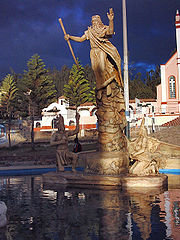
Bochica
Encyclopedia

Muisca mythology
Muisca mythology refers to the pre-Columbian beliefs of the Muisca culture about the origin and organization of the universe.- Creation of the universe :...
of the Muisca
Muisca
Muisca was the Chibcha-speaking tribe that formed the Muisca Confederation of the central highlands of present-day Colombia. They were encountered by the Spanish Empire in 1537, at the time of the conquest...
(Chibcha) culture, which existed during the arrival of the Spanish
Spain
Spain , officially the Kingdom of Spain languages]] under the European Charter for Regional or Minority Languages. In each of these, Spain's official name is as follows:;;;;;;), is a country and member state of the European Union located in southwestern Europe on the Iberian Peninsula...
conquistador
Conquistador
Conquistadors were Spanish soldiers, explorers, and adventurers who brought much of the Americas under the control of Spain in the 15th to 16th centuries, following Europe's discovery of the New World by Christopher Columbus in 1492...
es in areas comprising parts of present day Colombia
Colombia
Colombia, officially the Republic of Colombia , is a unitary constitutional republic comprising thirty-two departments. The country is located in northwestern South America, bordered to the east by Venezuela and Brazil; to the south by Ecuador and Peru; to the north by the Caribbean Sea; to the...
and Panama
Panama
Panama , officially the Republic of Panama , is the southernmost country of Central America. Situated on the isthmus connecting North and South America, it is bordered by Costa Rica to the northwest, Colombia to the southeast, the Caribbean Sea to the north and the Pacific Ocean to the south. The...
. He was the founding hero of their civilization, who according to legend brought morals and laws to the people and taught them agriculture and other crafts.
Similarly to the Incan god Viracocha
Viracocha
Viracocha is the great creator god in the pre-Inca and Inca mythology in the Andes region of South America. Full name and some spelling alternatives are Apu Qun Tiqsi Wiraqutra and Con-Tici Viracocha...
, the Aztec
Aztec
The Aztec people were certain ethnic groups of central Mexico, particularly those groups who spoke the Nahuatl language and who dominated large parts of Mesoamerica in the 14th, 15th and 16th centuries, a period referred to as the late post-classic period in Mesoamerican chronology.Aztec is the...
god Quetzalcoatl
Quetzalcoatl
Quetzalcoatl is a Mesoamerican deity whose name comes from the Nahuatl language and has the meaning of "feathered serpent". The worship of a feathered serpent deity is first documented in Teotihuacan in the first century BCE or first century CE...
and several other deities from Central and South American pantheons, Bochica is described in legends as being bearded. The beard, once mistaken as a mark of a prehistoric European influence and quickly fueled and embellished by spirits of the colonial era, had its single significance in the continentally insular culture of Mesoamerica. The "Anales de Cuauhtitlan" is a very important early source which is particularly valuable for having been originally written in Nahuatl. The Anales de Cuauhtitlan describes the attire of Quetzalcoatl at Tula:
"Immediately he made him his green mask; he took red color with which he made the lips russet; he took yellow to make the facade; and he made the fangs; continuing, he made his beard of feathers..." (Anales de Cuauhtitlan., 1975, 9.)"
In this quote the beard is represented as a dressing of feathers, fitting comfortably with academic impressions of Mesoamerican art. The connotation of the word 'beard' by Spanish colonizers was grossly abused as foundation for embellishment and fabrication of an original European influence in Mesoamerica.
Interestingly, not one cultural representation of either of these gods, painted, sculpted, et cetera, show them bearded in any sense the Spanish colonizers believed they would have been. No evidence in the abundance of Mesoamerican art are their signs of European influence, most stridently ruled out by the likenesses they gave themselves and their gods.
There have been questions on the authenticity of the preserved stories, and to what level they have been corrupted by the beliefs and imagery incorporated by Spanish Christian missionaries
Missionary
A missionary is a member of a religious group sent into an area to do evangelism or ministries of service, such as education, literacy, social justice, health care and economic development. The word "mission" originates from 1598 when the Jesuits sent members abroad, derived from the Latin...
and monks who first chronicled the native legends.
Legend
According to Chibcha legends, Bochica was a bearded man who came from the east. He taught the primitive Chibcha people ethical and moral norms and gave them a model by which to organize their states, with one spiritual and one secular leader. Bochica also taught the people agriculture, metalworking and other crafts before leaving for the west to live as an ascetic. When the Chibcha later forsook the teachings of Bochica and turned to a life of excess, a flood engulfed the Savannah of BogotáSavannah of Bogotá
The Savanna of Bogotá is a high plateau located in the center of Colombia on the eastern cordillera of the Colombian Andes. It is on the southern part of a larger plateau called Altiplano Cundiboyacense that rises to an average altitude of 2600 mts above the see level.This plateau is crossed from...
, where they lived. Upon appealing for aid from their hero, Bochica returned on a rainbow and with a strike from his staff, created the Tequendama Falls
Tequendama Falls
The Tequendama Falls is a 132m high waterfall on the Bogotá River, located about 30 km southwest of Bogotá in the municipality of San Antonio del Tequendama...
, through which the floodwaters could drain away.

